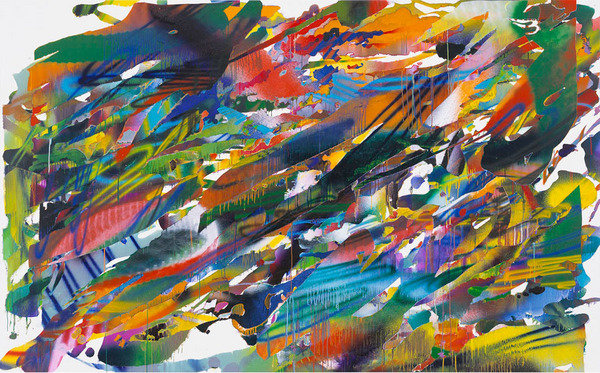Sprayed
dal 9/6/2015 al 31/7/2015
Segnalato da
Justin Adian
Richard Artschwager
Tauba Auerbach
Martin Barre
Jean Michel Basquiat
David Batchelor
Dike Blair
John Chamberlain
Dan Christensen
Dan Colen
Ida Ekblad
Jeff Elrod
Jack Goldstein
Piero Golia
Kim Gordon
Katharina Grosse
Wade Guyton
Richard Hamilton
Keith Haring
Hans Hartung
Alex Israel
Paul Klee
Jeff Koons
Harmony Korine
John Latham
Joseph Logan
Nate Lowman
Olivier Mosset
Takashi Murakami
Albert Oehlen
Jules Olitski
David Ostrowski
Steven Parrino
Sigmar Polke
Stephen Prina
Ugo Rondinone
Pamela Rosenkranz
Sterling Ruby
Ed Ruscha
Mira Schendel
Julian Schnabel
David Smith
Rudolf Stingel
Blair Thurman
Charline von Heyl
Andy Warhol
Lawrence Weiner
Franz West
Michael Williams
Christopher Wool
Richard Wright
Jona Lueddeckens
Greg Bergner
9/6/2015
Sprayed
Gagosian Gallery, London
This exhibition spanning four generations explores the myriad ways in which artists have employed the impulsive yet de-personalized and non-gestural forces of spray. It begins with Paul Klee's work on paper Seltsames Theater (1929), where he improvised with a blowpipe to achieve hazy background effects in a circus scene.

Curated by: Jona Lueddeckens and Greg Bergner.
This extensive exhibition spanning four generations explores the myriad ways in which artists have employed the impulsive yet de-personalized and non-gestural forces of spray. It begins with Paul Klee's work on paper Seltsames Theater (1929), where he improvised with a blowpipe to achieve hazy background effects in a circus scene. This tentative experiment presaged the bold and diverse artistic licence that would come with the post-war advent of aerosol paint as a consumer product and the use of the industrial paint compressor.
From the mid-1950s, sculptor David Smith sprayed enamels over various studio objects and offcuts laid on canvas and paper as stencils; the resulting images recalled Paleolithic cave paintings made by blowing pigment over hands pressed flat. John Chamberlain blurred the lines between painting and sculpture by torquing scrap automobile parts into painterly abstractions, then enhancing the original paint surface with fresh sprays of coloured lacquer. Lawrence Weiner's interaction with the medium resulted in a simple, dispassionate instruction: Two Minutes of Spray Paint Directly Upon the Floor From a Standard Aerosol Spray Can (1968); while Martin Barré tested it at different distances and pressures in a series of rapid strikes producing sequences of stripes and cryptic punctuations on paper.
From the late sixties, spray assumed a new scale and level of exposure, from Dan Christensen's vast “post-painterly” abstractions—where he used a spray gun to create intersecting coloured loops of paint alive with cool-tempered energies—and Jules Olitski's ethereal gradations of tone, texture, and depth; to Richard Artschwager's furtive urban Blps; Jean-Michel Basquiat's existential aphorisms tagged on New York City walls; and Keith Haring's exuberant political pictography that covered bodies, canvases, and subways. In the ultimate debunking of Ab Ex posturing, Andy Warhol produced a series of alchemical Oxidation Paintings by urinating on canvases primed with metallic paint.
Artists who came to prominence in the 1990s, such as Albert Oehlen, Christopher Wool, and Rudolf Stingel continue both to employ and emulate spray in sophisticated painterly compositions that uphold a formal tension between direct and indirect mark-making, free-form and control. In recent years, further exploration of this zone between deliberation and contingency has resulted in Tauba Auerbach's subtle creased canvases, Sterling Ruby's huge landscapes in which undelineated forms merge with atmospheric neon layers, and Kim Gordon's Wreath Paintings, which use readymade decorative wreaths as stencils for vertiginous abstractions. Katharina Grosse—a standout in the current Venice Biennale with her entropic environment enlivened with “radioactive” colour—underscores the urgent temporality of the medium in intricately layered canvases where the action of painting overlaps and intersects at different frequencies.
Image: Katharina Grosse , Untitled, 2015, Acrylic on canvas, 94 1/2 × 152 3/4 inches (240 × 388 cm), © Katharina Grosse und VG Bild-Kunst Bonn, 2015
Press Contact:
Erica Bolton, erica.bolton@boltonquinn.com
Opening reception: Wednesday, June 10th, from 6:00 to 8:00pm
Gagosian Gallery
6-24 Britannia Street
Hours: Tue–Sat 10-6



